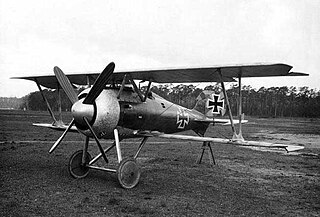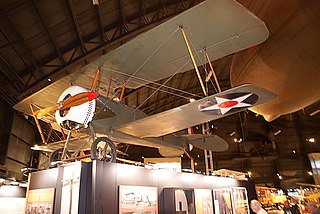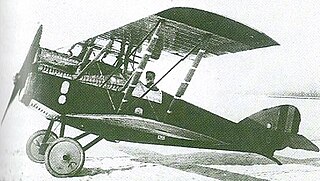
The Aero Ae 04 was a Czechoslovakian biplane fighter aircraft of 1921. A development of the Ae 02, it was no more successful than its predecessor in attracting purchase orders, and it flew only in prototype form. Undaunted by the lack of interest, development continued as the A.18.

The Albatros D.V is a fighter aircraft of the German aircraft manufacturer Albatros Flugzeugwerke. It was the final development of the Albatros D.I family and the last Albatros fighter to see operational service with the Luftstreitkräfte during the First World War.

The Fairey Pintail was a British single-engine floatplane fighter of the 1920s. While it was developed by Fairey as a reconnaissance fighter for the Royal Air Force, the only orders placed were for three for the Imperial Japanese Navy.

The Siemens-Schuckert D.III was a German single-seat fighter built by Siemens-Schuckert Werke. The D.III was a development of the earlier Siemens-Schuckert D.IIc prototype. The D.III was an (nearly) equal-span biplane powered by a 160 hp (119 kW) Siemens-Halske Sh.III bi-rotary engine. Idflieg placed an order for 20 aircraft in December 1917, followed by a second order of 30 aircraft in February 1918.

The Curtiss XP-31 Swift was a 1930s American experimental monoplane fighter built by Curtiss for the United States Army Air Corps.

The Hansa-Brandenburg CC was a single-seat German fighter flying boat of World War I. It was used by both the Kaiserliche Marine and the Austro-Hungarian Navy.

The Thomas-Morse S-4 Scout was an American biplane advanced trainer, operated by the United States Army and the United States Navy. Dubbed the "Tommy" by pilots who flew it, the aircraft became the favorite single-seat training airplane produced in the U.S. during World War I. It had a long and varied career beginning with the S-4B, which first appeared in the summer of 1917.

The Junkers CL.I was a ground-attack aircraft developed in Germany during World War I. Its construction was undertaken by Junkers under the designation J 8 as proof of Hugo Junkers' belief in the monoplane, after his firm had been required by the Idflieg to submit a biplane as its entry in a competition to select a ground-attack aircraft.
The Schütte-Lanz D.IV was a German fighter prototype during World War I. It was developed in parallel with the Schütte-Lanz D.III, however the two fighters had nothing in common. The D.IV was made of wood and was a single-bay staggered biplane with N-type interplane struts and ailerons on both upper and lower mainplanes. It first flew in late 1917 and was found to be inferior to the Schütte-Lanz D.III, and as a result production was not started.
The Fairey F.2 was a British fighter prototype in the late 1910s. It was the first aircraft designed entirely by the Fairey Aviation Company.

The New Standard D-25 was a 5-seat agricultural and joy-riding aircraft produced in the US from 1928.

The Morane-Saulnier AI was a French parasol-wing fighter aircraft produced by Morane-Saulnier during World War I.

The Marchetti MVT, later renamed SIAI S.50, was an Italian fighter of 1919 and the early 1920s.

The SIAI S.58 or Savoia-Marchetti S.M.58 was an Italian flying boat fighter prototype of the 1920s designed and manufactured by SIAI.

The Pomilio Gamma was an Italian fighter prototype of 1918.

The Praga BH-44 was a prototype Czechoslovak fighter biplane of the early 1930s. Only two were built, the rival Avia B-34 being ordered instead.
The Potez 230 was a French lightweight single-seat, single-engined fighter aircraft. One prototype was built and flew in 1940, but no production followed, with the prototype being captured and shipped to Germany for study.

The LFG Roland D.IX was a World War I German single seat fighter aircraft, a biplane powered by one of a new generation of powerful rotary engines. Three slightly different prototypes were built but there was no series production.

The Lohner Type AA were a series of prototype fighters built during World War I. The program would eventually be cancelled due to inherent instability concerns of the design.

In October 1917 Nieuport began construction of a prototype monoplane fighter known as the Nieuport Madon, a strut braced monoplane.

















